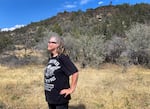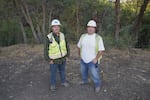The Klamath dam removal is uncovering painful history for the Shasta Indian Nation. But the tribe’s leaders also see a chance to recover some of their lost lands, restoring ceremony, language, and community in the process.

Sami Jo Difuntorum, cultural preservation officer for the Shasta Indian Nation, stands in the homeland of her tribe along the Klamath River in Northern California.
Cassandra Profita / OPB
When Sami Jo Difuntorum looks out across Copco Lake, she reads her own history in a sacred landscape that was nearly erased from public consciousness.
“You can see over there where the canyon narrows is where the historic river channel is — our traditional fishing site,” says Difuntorum. “It’s where we fished since time immemorial, as we say. We’re looking forward to that returning for future generations.”
Copco Lake is part of the Lower Kamath Project, a series of four dams and associated hydroelectric plants on the Klamath River near the Oregon-California border. The rugged country is marked by rolling foothills, rimrock rising out of oak woodlands, and the veins of shady creeks. This is K’íka·c’é·ki, the Shasta Indian Nation’s ancestral landscape, its heart currently submerged under the reservoir. Bound by Iron Gate dam to the west and a distinctive rock outcropping called Án·iruyruyhé·nax to the east, K’íka·c’é·ki encompasses the largest known Shasta village, smaller villages, camps, and fishing sites, a cemetery, and the site of their salmon ceremony.
Displaced first by gold miners and pioneers in the 19th century and by a massive hydroelectric project in the 20th, Shasta people have not had a place to call their own for over 100 years.
“We’re not homeless or houseless, but we’re away from home,” says Difuntorum, who serves as cultural preservation officer for the Shasta Indian Nation.
That may soon change. Next year, the three reservoirs of the Lower Klamath Project will be drained, and the dams and other infrastructure will be removed. Although the project is uncovering painful history for Shasta people, the tribe’s leaders also see a chance to recover some of their lost lands, restoring ceremony, language, and community in the process.
A tenuous hold
Multiple bands of indigenous people who spoke various dialects of the Shasta language once lived throughout northern California and the Klamath Mountains region. They were salmon people, thriving on the rivers’ abundant fish runs and the wealth of game and food plants in the uplands.
Gold miners arrived first in the Scott and Shasta Valleys, killing and displacing Indians wherever they went. Gold was discovered near Yreka in 1851, setting off a grim and bloody chapter for the Shasta who lived in the upper Klamath River canyon. While many were killed and some dispersed to nearby towns, a good number found a refuge in the fertile bottomlands along the Klamath River east of Yreka under the leadership of a Shasta chief named Bogus Tom Smith.
Bogus Tom was instrumental in spreading the Ghost Dance, a ritual believed to have the power to drive white settlers away, throughout Northern California and Oregon, says Dr. Brian Daniels, director of research and programs for the Penn Cultural Heritage Center at the University of Pennsylvania Museum. “During his travels he learned from other tribes that were fighting to hold onto their land.”
By the turn of the century, this group of Shasta had stitched together a land base by obtaining allotments, marrying into landowning families, and through outright purchase.
“It wasn’t as if the Bureau of Indian Affairs came in and said, ‘Oh, we’re gonna protect this land for you,’” says Daniels, who over the years has become a trusted advocate for the tribe. “This was the tribe itself holding itself together by owning or controlling these contiguous lands.”
Difuntorum’s own grandmother, Kitty Grasshopper, married a succession of white landowners, in part, Difuntorum suspects, so she could remain living on the land and near her people.
“They paid a price,” says Difuntorum of the tribe’s women, adding that strategic arranged marriages were not uncommon. “All of those efforts to keep the community intact? Guess what—the land was taken by eminent domain.”
In the early 1900s, Siskiyou Electric Power & Light Company began planning a large hydroelectric project on the Klamath River to serve its rapidly growing transmission network. In 1911, the company reorganized as California-Oregon Power Company, or Copco, and began acquiring land for the project.
A Shasta Indian woman named Kitty Ward, who had married a white rancher named Tip Ward, was living in a log cabin located on the lower end of the future reservoir when John C. Boyle, a surveyor who would go on to become vice president and long-time manager of Copco, delivered the news that she was going to have to move.
“She certainly knew how to put the white man in his place,” wrote Boyle in 50 Years on the Klamath, his account of the project. “Between sobs and tears, she refused again and again to leave her home[,] saying[,] ‘I no move, let water come, I die here.’” A ranch foreman persuaded Ward to travel to nearby Hornbrook. According to Daniels, she died of a cerebral hemorrhage in the process and never returned home.
A landscape transformed
Ultimately, six dams were built on the main stem of the Klamath River as part of the Klamath Hydroelectric Project. A curved concrete gravity arch dam called Copco 1 was constructed at the head of Ward’s Canyon, while the much smaller Copco 2 dam spanned the Klamath River just 500 yards below. Copco 2 was used to divert water through a tunnel and feed a hydroelectric plant two miles downstream, leaving most of Ward’s Canyon, a steep basalt gorge that Boyle deemed “unsurveyable,” dewatered for over a century.

Copco 1 dam will be removed sometime next year. Copco Lake is part of the Lower Kamath Project, a series of four dams and associated hydroelectric plants on the Klamath River near the Oregon-California border.
Juliet Grable / JPR
Once filled, Copco Lake submerged Shasta villages and ceremonial sites and flooded the most fertile farmland, while the dams blocked salmon and other fish, making it difficult for Shasta people to survive on even a subsistence level. The Shasta Indian Nation was not formally recognized as a sovereign entity by the federal government and no reservation was designated. According to Daniels, the last bit of property held by someone from Bogus Tom’s Shasta community was sold in 1968.
“It’s fascinating to me that when that person died, that property reverted to PacifiCorp,” says Daniels of the utility that, until recently, managed the dams. “And so, you really get a sense of just how much this community ends up getting pushed out.”
Along with the reservoirs and dams came powerhouses with turbines to generate power, penstocks to shuttle water to the power plants, transmission lines to move electricity, and even housing for dam workers.
This past summer, Copco 2 was partially deconstructed, and in September, the Yurok Tribe Construction Corporation and Yurok Fisheries Department worked with a local helicopter company to remove cottonwood and alder trees that had filled in Ward’s Canyon. The trees were destined to die once waterlogged, and would have created hazards for anglers and recreational boaters when the river returned. The work was done in collaboration with the Shasta Indian Nation, which has appointed cultural monitors to be on site any time ground disturbing activities take place. They understand that the reservoir drawdowns and earth moving could uncover sacred sites, including burials.
“It can be hard to be here,” says Michael Olson, council member for the Shasta Indian Nation who is serving as a cultural monitor. At the same time, the tribe has been in consultation with the state of California about the possibility of having some of their ancestral lands returned to them.

Serving as tribal cultural monitors for the Shasta Indian Nation are Willis Hindle (left), who is related to Kitty Grasshopper, and Larry Leonard, who is Kitty Ward’s grandson.
Courtesy of Klamath River Renewal Corporation
When the license to operate the dams was officially transferred to the nonprofit Klamath River Renewal Corporation in late 2022, PacifiCorp also handed off about 8,000 acres of land, including the acreage underneath the reservoirs. These “Parcel B” lands will be transferred to the states of Oregon and California or to a third-party designee once the dams are removed and the reservoir footprints are restored.
“What is going to make this okay to the extent that it can be? One of the mitigation measures in the [state’s environmental] document is return of land,” says Difuntorum. The climate in California is favorable, she adds, pointing to Governor Gavin Newsom’s directive to return “excess land” to California tribes.
Shasta leaders are focused on the parts of their homeland with the most cultural significance. Any return of land will have to be balanced with the dams’ Surrender Order, which mandates that any transferred lands be managed for “public interest purposes” such as wildlife habitat restoration and recreation.
“What’s compelling and important here is it was a state action that deprived this tribal community of its property,” says Daniels. “That really prompts me to reflect on what needs to happen in this space. How do you remedy a state action that was so devastating?”
Reclaiming language and place
The Ghost Dance wasn’t part of the Shasta’s traditional ceremonies, which centered around salmon, but they began practicing it in the 1870s, after Indians from further south brought it to them as a way to resist colonization.
Difuntorum describes the Ghost Dance as a “very earnest prayer” to return life to the way it was before the gold miners came. Though it may be impossible to turn back the clock to a time before colonization, dam removal offers an opportunity to right historic wrongs — and for healing.
“The health of the land and water is not a snap kind of thing; it’s about creating a cycle and being part of that,” says Sarmento.

Linguist James Sarmento is eager to share the Shasta language with other members of his community.
Courtesy of Juliet Grable/JPR
Sarmento, who describes himself as a “big, library nerd,” says his interest in language ignited in 2007, when he discovered linguist Shirley Silver’s 1966 dissertation titled The Shasta Language.
Discovering the text was “super exciting,” says Sarmento. “I knew nothing about linguistics.”
Sarmento eventually met Silver, who had worked with Íkʔya·hámpik, also known as Sargent Sambo, who was the last fluent Shasta speaker in the world until his death in 1963. Now, Sarmento has become a vital link in a chain of individuals working to keep the flame of the Shasta language flickering, despite enormous challenges.
As Sarmento points out in the early pages of his own doctoral dissertation, called The Shasta Language: A One-Hundred Year Conversation, there are no fluent speakers alive today, and Shasta people are scattered “across California, Oregon, and beyond” — a consequence of limited economic opportunities and the absence of a land base.
Now that the dams are being removed, Sarmento is eager to help Shasta people use language to reclaim physical spaces within K’íka·c’é·ki—and to gather with his community.
“Being a part of that ceremonial space is incredibly powerful—having a sense of belonging,” says Sarmento, recalling an experience when he and his family were invited to a roundhouse near Sacramento. “Ceremony and these spaces are not just for the community, they’re for the world, so the world can renew itself.”
The Shasta plan to have a continuous presence in the area once the reservoir drawdowns begin in early 2024.
“We’re good with [the dams] coming out,” says Difuntorum. “We want fish but we also want some of our lands back. I look at my little grandsons and it’s like — they deserve to have culture — to have ceremony, to have tradition.”